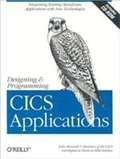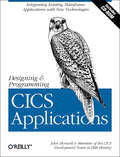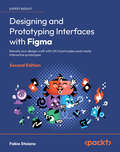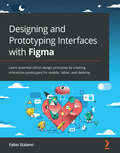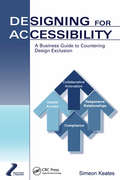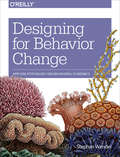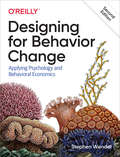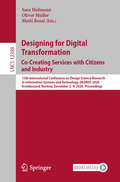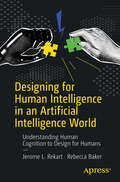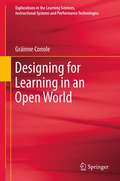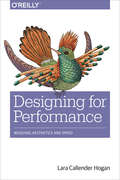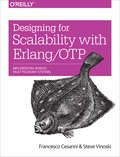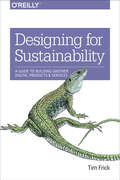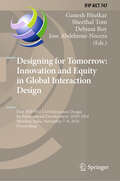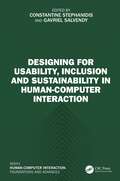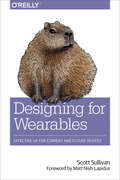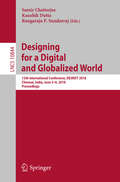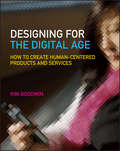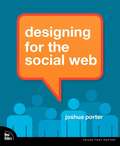- Table View
- List View
Designing and Programming CICS Applications
by John Horswill Members of the CICS Development Team at IBM HursleyCICS is an application server that delivers industrial-strength, online transaction management for critical enterprise applications. Proven in the market for over 30 years with many of the world's leading businesses, CICS enables today's customers to modernize and extend their applications to take advantage of the opportunities provided by e-business while maximizing the benefits of their existing investments. Designing and Programming CICS Applications will benefit a diverse audience. It introduces new users of IBM's mainframe (OS/390) to CICS features. It shows experienced users how to integrate existing mainframe systems with newer technologies, including the Web, CORBA, Java, CICS clients, and Visual Basic; as well as how to link MQSeries and CICS. Each part of Designing and Programming CICS Applications addresses the design requirements for specific components and gives a step-by-step approach to developing a simple application. The book reviews the basic concepts of a business application and the way CICS meets these requirements. It then covers a wide range of application development technologies, including VisualAge for Java, WebSphere Studio, and Visual Basic. Users learn not only how to design and write their programs but also how to deploy their applications. Designing and Programming CICS Applications shows how to: Develop and modify existing COBOL applications Become familiar with the CICS Java environment and write a simple Java wrapper for a COBOL application Develop a web front end using servlets, JSP and JavaBeans. Link the web front end to an existing COBOL application using CORBA Write a Visual Basic application to develop a customer GUI Link an existing COBOL application using a CICS Client ECI call Develop a Java application using Swing as an MQSeries Client Use the MQSeries-CICS bridge to access an existing COBOL application Whether for working with thousands of terminals or for a client/server environment with workstations and LANs exploiting modern technology such as graphical interfaces or multimedia, Designing and Programming CICS Applications delivers the power to create, modernize and extend CICS applications.
Designing and Prototyping Interfaces with Figma: Elevate your design craft with UX/UI principles and create interactive prototypes
by Fabio StaianoExplore the latest Figma features with this newly updated 2nd edition, including Variables and Conditional Prototyping. Learn cutting-edge design principles and create captivating interfaces with this full-color guide.Key FeaturesExplore Figma's latest features, including Variables and Conditional Prototyping, to create dynamic and responsive interfacesIntegrate AI capabilities and optimize your workflow with the latest Figma pluginsCreate engaging, interactive prototypes that captivate your users and stakeholdersPurchase of the print or Kindle book includes a free PDF eBookBook DescriptionAre you a UI/UX designer eager to learn the art of creating compelling interfaces using Figma? Look no further! The highly anticipated new edition is here to transform your creative journey. Explore Figma's latest features and delve into the power of variables and conditional Prototyping. Get ready to transform your static designs into dynamic, interactive prototypes, offering users and stakeholders an immersive experience. Stay at the forefront of design innovation with insights into integrating AI capabilities and optimizing your workflow with the latest Figma plugins. With user-centric design at its core, this book guides you through mastering design thinking, enabling you to tackle complex design challenges with ease. One unique aspect of this edition is its focus on effective communication. Learn how to convey your design vision clearly to both technical and non-technical audiences. In the rapidly changing world of UI/UX design, iteration is key. This book will teach you how to gather user feedback and iterate on your designs by creating interactive prototypes. Whether you're new to Figma or a seasoned pro, this comprehensive guide equips you with the skills to create captivating interfaces, fosters creativity and problem-solving, and makes you an indispensable, forward-thinking designer.What you will learnCreate high-quality designs that cater to your users' needs, providing an outstanding experienceMastering mobile-first design and responsive design conceptsIntegrate AI capabilities into your design workflow to boost productivity and explore design innovationCraft immersive prototypes with conditional prototyping and variablesCommunicate effectively to technical and non-technical audiencesDevelop creative solutions for complex design challengesGather and apply user feedback through interactive prototypesWho this book is forThis book is for aspiring UX/UI designers who want to get started with Figma as well as established designers who want to migrate to Figma from other design tools. This guide will provide you a walkthrough of the entire process of creating a full-fledged prototype for a responsive interface using all the tools and features that Figma has to offer. As a result, this book is suitable for both UX and UI designers, product and graphic designers, as well as anyone who wants to explore the complete design process from scratch.
Designing and Prototyping Interfaces with Figma: Learn essential UX/UI design principles by creating interactive prototypes for mobile, tablet, and desktop
by Fabio StaianoDiscover user experience and user interface design best practices while mastering a wide array of tools across Figma and FigJam with this full-color guideKey FeaturesLearn the basics of user experience research, result organization, and analysis in FigJamCreate mockups, interactive animations, and high-fidelity prototypes using this platform-independent web application toolCollaborate with a team in real-time and create, share, and test your designsBook DescriptionA driving force of the design tools market, Figma makes it easy to work with classic design features while enabling unique innovations and opening up real-time collaboration possibilities. It comes as no surprise that many designers decide to switch from other tools to Figma.In this book, you'll be challenged to design a user interface for a responsive mobile application having researched and understood user needs. You'll become well-versed with the process in a step-by-step manner by exploring the theory first and gradually moving on to practice. You'll begin your learning journey by covering the basics of user experience research with FigJam and the process of creating a complete design using Figma tools such as Components, Variants, Auto Layout, and much more. You'll also learn how to prototype your design and explore the potential of community resources such as templates and plugins.By the end of this Figma book, you'll have a solid understanding of the user interface workflow, managing essential Figma tools, and organizing your workflow.What you will learnExplore FigJam and how to use it to collect data in the research phaseWireframe the future interface with shape tools and vectorsDefine grids, typography, colors, and effect styles that can be reused in your workGet to grips with Auto Layout and the constraints to create complex layoutsCreate flexible components using styles and variantsMake your user interface interactive with prototyping and smart animateShare your work with others by exporting assets and preparing development resourcesDiscover templates and plugins from the communityWho this book is forThis book is for aspiring UX/UI designers who want to get started with Figma as well as established designers who want to migrate to Figma from other design tools. This guide will take you through the entire process of creating a full-fledged prototype for a responsive interface using all the tools and features that Figma has to offer. As a result, this Figma design book is suitable for both UX and UI designers, product and graphic designers, and anyone who wants to explore the complete design process from scratch.
Designing for Accessibility: A Business Guide to Countering Design Exclusion (Human Factors and Ergonomics)
by Simeon KeatesA step by step guide, this book covers how to design products that offer the right combination of functionality, usability, and accessibility for all consumers. The author articulates why these three elements can make the critical difference in remaining competitive and economically viable over the long term. He provides insightful case studies that illustrate the corporate benefits for designing accessibility, in addition to carefully selected and valuable figures and tables. Demystifying what is involved in designing inclusive products for all users, the book highlights numerous examples for designers, such as creating a tool for Web browsing for older adults, as well as digital television access.
Designing for Behavior Change: Applying Psychology and Behavioral Economics
by Stephen WendelA new wave of products is helping people change their behavior and daily routines, whether it's exercising more (Jawbone Up), taking control of their finances (HelloWallet), or organizing their email (Mailbox). This practical guide shows you how to design these types of products for users seeking to take action and achieve specific goals. Stephen Wendel, HelloWallet's head researcher, takes you step-by-step through the process of applying behavioral economics and psychology to the practical problems of product design and development. Using a combination of lean and agile development methods, you'll learn a simple iterative approach for identifying target users and behaviors, building the product, and gauging its effectiveness. Discover how to create easy-to-use products to help people make positive changes. Learn the three main strategies to help people change behavior Identify your target audience and the behaviors they seek to change Extract user stories and identify obstacles to behavior change Develop effective interface designs that are enjoyable to use Measure your product's impact and learn ways to improve it Use practical examples from products like Nest, Fitbit, and Opower
Designing for Behavior Change: Applying Psychology and Behavioral Economics
by Stephen WendelDesigners and managers hope their products become essential for users—integrated into their lives like Instagram, Lyft, and others have become. Such deep integration isn’t accidental: it’s a process of careful design and iterative learning, especially for technology companies. This guide shows you how to apply behavioral science—research that supports many products—to help your users achieve their goals using your product.In this updated edition, Stephen Wendel, head of behavioral science at Morningstar, takes you step-by-step through the process of incorporating behavioral science into product design and development. Product managers, UX and interaction designers, and data analysts will learn a simple and effective approach for identifying target users and behaviors, building the product, and gauging its effectiveness.Learn the three main strategies to help people change behaviorIdentify behaviors your target audience seeks to change—and obstacles that stand in their wayDevelop effective designs that are enjoyable to useMeasure your product’s impact and learn ways to improve itCombine behavioral science with data science to pinpoint problems and test potential solutions
Designing for Digital Transformation. Co-Creating Services with Citizens and Industry: 15th International Conference on Design Science Research in Information Systems and Technology, DESRIST 2020, Kristiansand, Norway, December 2–4, 2020, Proceedings (Lecture Notes in Computer Science #12388)
by Oliver Müller Sara Hofmann Matti RossiThis book constitutes the thoroughly refereed proceedings of the 15th International Conference on Design Science Research in Information Systems and Technology, DESRIST 2020, held in Kristiansand, Norway, in December 2020. The 28 revised full research papers included in the volume together with 7 research-in-progress papers and 9 prototype papers, were carefully reviewed and selected from 93 submissions. They are organized in the following topical sections: digital public services; data science; design principles; methodology; platforms and networks; and service science. Due to the Corona pandemic this event was held virtually.
Designing for Emerging Technologies: UX for Genomics, Robotics, and the Internet of Things
by Jonathan FollettThe recent digital and mobile revolutions are a minor blip compared to the next wave of technological change, as everything from robot swarms to skin-top embeddable computers and bio printable organs start appearing in coming years. In this collection of inspiring essays, designers, engineers, and researchers discuss their approaches to experience design for groundbreaking technologies.Design not only provides the framework for how technology works and how it’s used, but also places it in a broader context that includes the total ecosystem with which it interacts and the possibility of unintended consequences. If you’re a UX designer or engineer open to complexity and dissonant ideas, this book is a revelation.Contributors include:Stephen Anderson, PoetPainter, LLCLisa Caldwell, Brazen UXMartin Charlier, Independent Design ConsultantJeff Faneuff, CarboniteAndy Goodman, Fjord USCamille Goudeseune, Beckman Institute, University of Illinois at Urbana-ChampaignBill Hartman, Essential DesignSteven Keating, MIT Media Lab, Mediated Matter GroupBrook Kennedy, Virginia TechDirk Knemeyer, Involution StudiosBarry Kudrowitz, University of MinnesotaGershom Kutliroff, Omek Studio at IntelMichal Levin, GoogleMatt Nish-Lapidus, NormativeErin Rae Hoffer, AutodeskMarco Righetto, SumAllJuhan Sonin, Involution StudiosScott Stropkay, Essential DesignScott Sullivan, Adaptive PathHunter Whitney, Hunter Whitney and Associates, Inc.Yaron Yanai, Omek Studio at Intel
Designing for Human Intelligence in an Artificial Intelligence World: Understanding Human Cognition to Design for Humans
by Rebecca Baker Jerome L. RekartHow we think and react has a direct impact on experience design, but often designers don't understand the "whys" behind their best practices, leaving them at risk for misusing or underutilizing those designs. Similarly, psychologists/neuroscientists don't understand the design decisions that their science is informing and how they might be leveraged further. This book explores how neuroscience and cognitive psychology inform experience design, within the modern context of research and technological advances. With a conversational and playful tone, this book begins by grounding you in research and AI. That foundation then allows you to expand your repertoire through chapters on design-relevant cognitive phenomena such as memory, learning, and perception. By delving into how our brains handle these processes and how our designs can effectively (or ineffectively) leverage them, the book follows a journey that weaves academic learning with practical, real-world applications and examples. With the widespread availability of generative AI tools, understanding the intersection of human cognition and design and how that knowledge can be used to build a bridge between the brain and the software has become even more critical. By understanding the brain and human behavior more completely, designers will be able to effectively use AI as an accelerator for tactical projects and provide the context that is unique to the human ability to understand the "why.&”
Designing for Inclusion: Inclusive Design: Looking Towards the Future
by Jonathan Lazar Patrick Langdon Ann Heylighen Hua DongThis proceedings book presents papers from the 10th Cambridge Workshops on Universal Access and Assistive Technology. The CWUAAT series of workshops have celebrated a long history of interdisciplinarity, including design disciplines, computer scientists, engineers, architects, ergonomists, ethnographers, ethicists, policymakers, practitioners, and user communities. This reflects the wider increasing realisation over the long duration of the series that design for inclusion is not limited to technology, engineering disciplines, and computer science but instead requires an interdisciplinary approach. The key to this is providing a platform upon which the different disciplines can engage and see each other’s antecedents, methods, and point of view.This proceedings book of the 10th CWUAAT conference presents papers in a variety of topics includingReconciling usability, accessibility, and inclusive design;Designing inclusive assistive and rehabilitation systems;Designing cognitive interaction with emerging technologies;Designing inclusive architecture;Data mining and visualising inclusion;Legislation, standards, and policy in inclusive design;Situational inclusive interfaces; andThe historical perspective: 20 years of CWUAAT.CWUAAT has always aimed to be inclusive in the fields that it invites to the workshop. We must include social science, psychologies, anthropologies, economists, politics, governance, and business. This requirement is now energised by imminent new challenges arising from techno-social change. In particular, artificial intelligence, wireless technologies, and the Internet of Things generate a pressing need for more socially integrated projects with operational consequences on individuals in the built environment and at all levels of design and society. Business cases and urgent environmental issues such as sustainability and transportation should now be a focus point for inclusion in an increasingly challenging world. This proceedings book continues the goal of designing for inclusion, as set out by the CWUAAT when it first started.
Designing for Learning in an Open World
by Gráinne ConoleThe Internet and associated technologies have been around for almost twenty years. Networked access and computer ownership are now the norm. There is a plethora of technologies that can be used to support learning, offering different ways in which learners can communicate with each other and their tutors, and providing them with access to interactive, multimedia content. However, these generic skills don't necessarily translate seamlessly to an academic learning context. Appropriation of these technologies for academic purposes requires specific skills, which means that the way in which we design and support learning opportunities needs to provide appropriate support to harness the potential of technologies. More than ever before learners need supportive 'learning pathways' to enable them to blend formal educational offerings, with free resources and services. This requires a rethinking of the design process, to enable teachers to take account of a blended learning context.
Designing for Performance: Weighing Aesthetics and Speed
by Lara Callender HoganAs a web designer, you encounter tough choices when it comes to weighing aesthetics and performance. Good content, layout, images, and interactivity are essential for engaging your audience, and each of these elements have an enormous impact on page load time and the end-user experience. In this practical book, Lara Hogan helps you approach projects with page speed in mind, showing you how to test and benchmark which design choices are most critical.To get started, all you need are basic HTML and CSS skills and Photoshop experience.Topics include:The impact of page load time on your site, brand, and usersPage speed basics: how browsers retrieve and render contentBest practices for optimizing and loading imagesHow to clean up HTML and CSS, and optimize web fontsMobile-first design with performance goals by breakpointUsing tools to measure performance as your site evolvesMethods for shaping an organization’s performance culture
Designing for Privacy and its Legal Framework
by Aurelia Tamò-LarrieuxThis book discusses the implementation of privacy by design in Europe, a principle that has been codified within the European Data Protection Regulation (GDPR). While privacy by design inspires hope for future privacy-sensitive designs, it also introduces the need for a common understanding of the legal and technical concepts of privacy and data protection. By pursuing an interdisciplinary approach and comparing the problem definitions and objectives of both disciplines, this book bridges the gap between the legal and technical fields in order to enhance the regulatory and academic discourse. The research presented reveals the scope of legal principles and technical tools for privacy protection, and shows that the concept of privacy by design goes beyond the principle of the GDPR. The book presents an analysis of how current regulations delegate the implementation of technical privacy and data protection measures to developers and describes how policy design must evolve in order to implement privacy by design and default principles.
Designing for Scalability with Erlang/OTP: Implement Robust, Fault-Tolerant Systems
by Francesco Cesarini Steve VinoskiIf you need to build a scalable, fault tolerant system with requirements for high availability, discover why the Erlang/OTP platform stands out for the breadth, depth, and consistency of its features. This hands-on guide demonstrates how to use the Erlang programming language and its OTP framework of reusable libraries, tools, and design principles to develop complex commercial-grade systems that simply cannot fail.In the first part of the book, you’ll learn how to design and implement process behaviors and supervision trees with Erlang/OTP, and bundle them into standalone nodes. The second part addresses reliability, scalability, and high availability in your overall system design. If you’re familiar with Erlang, this book will help you understand the design choices and trade-offs necessary to keep your system running.Explore OTP’s building blocks: the Erlang language, tools and libraries collection, and its abstract principles and design rulesDive into the fundamentals of OTP reusable frameworks: the Erlang process structures OTP uses for behaviorsUnderstand how OTP behaviors support client-server structures, finite state machine patterns, event handling, and runtime/code integrationWrite your own behaviors and special processesUse OTP’s tools, techniques, and architectures to handle deployment, monitoring, and operations
Designing for Social Justice: Community-Engaged Approaches in Technical and Professional Communication (ATTW Series in Technical and Professional Communication)
by Jialei Jiang Tham, Jason C. K.Exploring the intersection of design research and community engagement, this book highlights the ways in which design and design theories can be used to address social justice issues and promote positive change in communities.Contributors illuminate the theoretical, ethical, and pedagogical dimensions of design-driven methods in community-engaged projects, exploring their potential to address critical social justice issues such as ethnic and racial justice, gender equality, disability justice, cultural diversity, equity, and environmental justice. Chapters examine various aspects of community-engaged practices, including the use of design theories to fuel social justice work in community partnerships, ethical issues surrounding the use of multimodal resources and new media technologies, and pedagogies for promoting social change. Addressing the opportunities and challenges of design and design methods in community engagement, this collection offers suggestions for promoting social justice through technical and professional communication activities and pedagogies.Investigating the design of community-engaged projects from a critical standpoint, this book will appeal to scholars and students in the fields of Technical and Professional Communication, Writing and Composition Studies, and Rhetoric. It will also be of interest to administrators, community partners, and professionals working in service-learning contexts.
Designing for Sustainability: A Guide to Building Greener Digital Products and Services
by Tim FrickPixels use electricity, and a lot of it. If the Internet were a country, it would be the sixth largest in terms of electricity use. That’s because today’s average web page has surpassed two megabytes in size, leading to slow load times, frustrated users, and a lot of wasted energy. With this practical guide, your web design team will learn how to apply sustainability principles for creating speedy, user-friendly, and energy-efficient digital products and services.Author Tim Frick introduces a web design framework that focuses on four key areas where these principles can make a difference: content strategy, performance optimization, design and user experience, and green hosting. You’ll discover how to provide users with a streamlined experience, while reducing the environmental impact of your products and services.Learn why 90% of the data that ever existed was created in the last yearUse sustainability principles to innovate, reduce waste, and function more efficientlyExplore green hosting, sustainable business practices, and lean/agile workflowsPut the right things in front of users at precisely the moment they need them—and nothing moreIncrease site search engine visibility, streamline user experience, and make streaming video more efficientUse Action Items to explore concepts outlined in each chapter
Designing for Tomorrow: First IFIP WG 13.8 Interaction Design for International Development, IDID 2024, Mumbai, India, November 7–9, 2024, Proceedings (IFIP Advances in Information and Communication Technology #747)
by Ganesh Bhutkar Sheethal Tom Debjani Roy Jose Abdelnour-NoceraThis book constitutes the refereed proceedings of the First IFIP Working Group 13.8 Interaction Design for International Development, IDID 2024, held in Mumbai, India, during November 7–9, 2024. The 14 full papers included in this book were carefully reviewed and selected from 17 submissions. The aim of this working group is to pursue research and promote the discipline of Human-Computer Interaction (HCI) in an international context. It also provides a platform, where both emerging and experienced researchers from academia and industry can converge to exchange their latest findings in the ever-evolving realm of HCI and International Development.
Designing for Usability, Inclusion and Sustainability in Human-Computer Interaction
by Gavriel Salvendy Constantine StephanidisAddressing the rising prevalence of interactive systems in our daily lives, this book focuses on the essential aspects of usability, user experience (UX), and inclusive design.This book Discusses both theoretical and practical aspects, approaches, and methods for the design process and the collaboration between HCI Design and Software Engineering. Expands to practical topics such as web and mobile design, aesthetics, information visu- alization, information architecture, and navigation design, along with relevant guidelines and standards. Tackles the issue of persuasive interfaces that has arisen as a crucial concern in the contemporary digitalized landscape. Emphasizes the importance of making computing systems inclusive and user-friendly for a diverse range of users, including children, older adults, and persons with disabilities. Highlights the significance of usability, underscoring its key role in enhancing the overall user experience of interactive products.This book has been written for individuals interested in Human-Computer Interaction research andapplications..
Designing for Wearables: Effective UX for Current and Future Devices
by Scott SullivanNow may be the perfect time to enter the wearables industry. With the range of products that have appeared in recent years, you can determine which ideas resonate with users and which don’t before leaping into the market. In this practical guide, author Scott Sullivan examines the current wearables ecosystem and then demonstrates the impact that service design in particular will have on these types of devices going forward.You’ll learn about the history and influence of activity trackers, smartwatches, wearable cameras, the controversial Google Glass experiment, and other devices that have come out of the recent Wild West period. This book also dives into many other aspects of wearables design, including tools for creating new products and methodologies for measuring their usefulness.You’ll explore:Emerging types of wearable technologiesHow to design services around wearable devicesKey concepts that govern service designPrototyping processes and tools such as Arduino and ProcessingThe importance of storytelling for introducing new wearablesHow wearables will change our relationship with computers
Designing for XOOPS: A Designer's Quickstart Guide to Content Management
by Sun RuoyuLearn how to customize websites with XOOPS, the open source CMS that helps non-developers build dynamic community websites, intranets, and other applications. This concise book shows you how to use XOOPS themes and modules to design everything from simple blogs to large database-driven CMS portals.Web designers and current XOOPS users will learn how to create a site theme with CSS and jQuery libraries, including techniques for making additional modules conform to the site's look and feel. Although XOOPS uses the PHP-based Smarty templating system, all you need is a bit of XHTML and CSS experience to get started.Learn the workflow for turning an idea into a full-featured websiteBecome familiar with XOOPS’ theme-building tools, and set up PHP and MySQL environmentsPort an existing XHTML template to XOOPSCreate themes with the 960 Grid System to save time and reduce codeUse jQuery-based UI libraries to achieve complex effectsBlend new modules into your theme with the template override functionGo beyond traditional block layouts to customize your homepage
Designing for a Digital and Globalized World: 13th International Conference, Desrist 2018, Chennai, India, June 3-6, 2018, Proceedings (Theoretical Computer Science and General Issues #10844)
by Samir Chatterjee Kaushik Dutta Rangaraja P. SundarrajThis book constitutes the proceedings of the 13th International Conference on Design Science Research in Information Systems and Technology, DESRIST 2018, held in June 2018 in Chennai, India. The 24 full papers presented in this volume were carefully reviewed and selected from 96 papers. The contributions are organized in topical sections named: HCI and Design, Design Foundations, Design Foundations, Design in Healthcare, Advances in Data Science and Analytics, ICT for Development, Designing Cybersecurity, and Design Applications.
Designing for iOS with Sketch
by Sian MorsonDesigning for iOS with Sketch takes you through the process of designing your iOS app using Bohemian Code's Sketch. Sketch is a powerful new design program that is quickly replacing Adobe PhotoShop for many designers designing for mobile apps and the mobile web. This book will introduce you to the program and then take you through the steps of designing your very own app. It includes examples and shortcuts as well as a helpful list of plugins and 3rd party resources that will greatly improve your workflow. What you'll learn What sets Sketch apart from PhotoShop and Illustrator Use Sketch to design a simple iOS app Learn helpful shortcuts to speed up your workflow Get a helpful list of resources from around the web Includes a list of plugins to extend Sketch and make designing more fun Who this book is for Beginning to intermediate iOS app designers who are looking for an alternative to PhotoShop. Table of Contents Chapter 1: Why Sketch? Chapter 2: The Sketch Interface Chapter 3: Shapes and Styles Chapter 4: Symbols Chapter 5: Text and Fonts Chapter 6: Optimizing Your Workflow Chapter 7: Creating a Simple App Chapter 8: Creating an Icon Chapter 9: Exporting Assets for Development Chapter 10: Sketch Resources and Plugins
Designing for the Digital Age: How to Create Human-Centered Products and Services
by Kim GoodwinWhether you're designing consumer electronics, medical devices, enterprise Web apps, or new ways to check out at the supermarket, today's digitally-enabled products and services provide both great opportunities to deliver compelling user experiences and great risks of driving your customers crazy with complicated, confusing technology. Designing successful products and services in the digital age requires a multi-disciplinary team with expertise in interaction design, visual design, industrial design, and other disciplines. It also takes the ability to come up with the big ideas that make a desirable product or service, as well as the skill and perseverance to execute on the thousand small ideas that get your design into the hands of users. It requires expertise in project management, user research, and consensus-building. This comprehensive, full-color volume addresses all of these and more with detailed how-to information, real-life examples, and exercises. Topics include assembling a design team, planning and conducting user research, analyzing your data and turning it into personas, using scenarios to drive requirements definition and design, collaborating in design meetings, evaluating and iterating your design, and documenting finished design in a way that works for engineers and stakeholders alike.
Designing for the Social Web
by Joshua PorterWith tons of examples from real-world interfaces and a touch of the underlying social psychology theory, Joshua Porter shows you how to design your next great social web application.
